
Let’s talk about how to teach estimation and measurement in a hands-on and visual way to third-grade students. Here’s how I want to break this down:
- What students need to know about measurement in third grade
- How to teach metric measurement and conversion
- How to promote student understanding of metric units
- Examples of fun metric measurement activities
If you prefer to hear me talk through all of this, here is a video with all of this content.
[0:43] What do students need to know about measurement in third grade?
Even though we are just interested in what third graders need to know about measurement, I want to mention the progression of this standard so we know what comes before and after third grade.
Before third grade, students are introduced to measurement tools (like rulers, yardsticks, and meter sticks) and have estimated and compared lengths.
The third-grade standards expect students to estimate and read measurements.
“Measure and estimate liquid volumes and masses of objects using standard units of grams (g), kilograms (kg), and liters (l). Add, subtract, multiply, or divide to solve one-step word problems involving masses or volumes that are given in the same units, e.g., by using drawings (such as a beaker with a measurement scale) to represent the problem.”
Here are the details of what this includes:
Students can relate units to common items. I want them to know, whenever I ask, that a paperclip is approximately a gram, a handbook is approximately a kilogram, a drop of water would be a milliliter and then a large water bottle would be a liter.
Students need to read exact measurements. I want them to experience measuring items in real life in addition to reading a measurement from a drawing. They need to be able to read measurements that fall on or between the lines of a ruler or scale.
Students need to approximate measurements and determine if a measurement that is given would be reasonable or not reasonable (For instance, if a swimming pool were filled with water, would it be more reasonable that it would have two liters of water or 300 liters of water?).
Students can solve multi-step word problems that have to do with measurement and estimation.
With this foundation, in fourth grade, they will be ready to convert larger units of measurement to smaller units. In fifth grade, they will be able to convert between any units of measurement.
[1:33] How do you introduce measurement to third-grade students?
In third grade, we are talking primarily about estimation and exact measurements. I’m going to take you through the CRA Model: the Concrete, Representational, and Abstract approach to teaching math.
- Concrete refers to hands-on activities using manipulatives that the students can touch.
- Representational activities allow students to take what they have learned in concrete form and expand upon it by creating drawings or other visual depictions of the concept.
- Abstract activities typically involve equations and algorithms.
[2:40] Milestones of the third-grade measurement standard
Next, I’ll point out the milestones, or the big parts of this standard that we need to break down and ensure our students can perform.
[4:09] Relate Units to Common Items
The focus of this standard that students and teachers most struggle with is grams, kilograms, liters, and milliliters. Since the U.S. has limited use of the metric system, students have trouble understanding how much each of these is. So I start by using an anchor chart (shown below) which relates the mass of one gram to one paperclip, the mass of one kilogram to a heavy book, and 1000 grams to one kilogram. It also includes that a few drops of water is about one milliliter and a large bottle of water is about one liter.
Once students have real-world items to relate the measurements to, I start asking them which unit would be the most appropriate to use for measuring a given item. For example, I might ask if the mass of an apple would be more appropriately shared as kilograms or grams. This concept lends itself nicely to games because it's not difficult for them but they do need repetition. I like to give them practice using task cards or Tic-Tac-Toe because choosing appropriate units is a simple idea. Once they can answer these questions, they begin to find success with estimating measurements when given choices (e.g., is a pen more likely to be 90 kg or 90 g?). If they can’t get this foundation, however, they will struggle with everything else related to measurement.
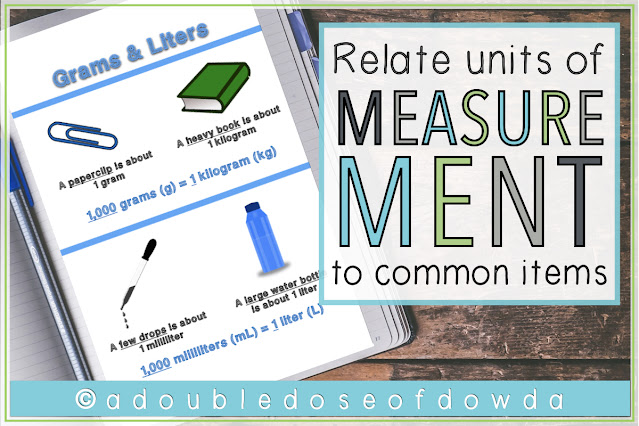
[6:10] Read Exact Measurements
The next part of the standard is for students to read measurements. I've used a lot of hands-on materials for this and have found it’s important to have different sized containers for measuring liters and milliliters as well as a few platform scales, balances, and weight sets (all pictured below) for students to share. I’ve found that students struggle the most with how to read scales, balances, and beakers, so the more hands-on practice they can get, the better. Begin with giving students measurements to read where the balance or beaker contents land on a labeled line for the scale.
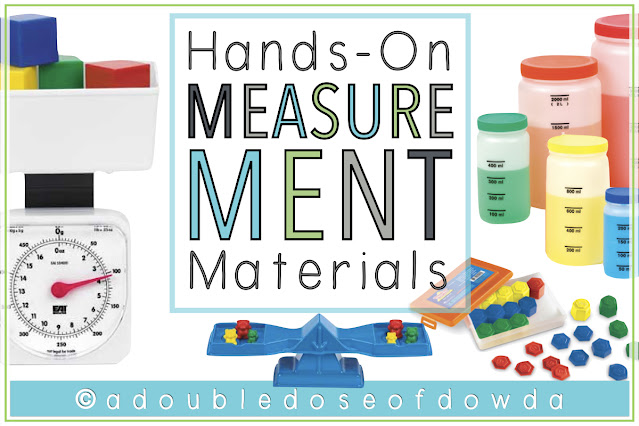
In addition to measuring items, they also need practice using these tools to show a precise measurement that's given. For instance, give students opportunities to fill a beaker to 250 milliliters. It’s just like what they’ve done before but reversed.
As students get some practice with measuring real items, I might give them a drawing of an empty beaker and ask them to draw what 400 milliliters of water looks like. They need to begin representing measurements by drawing pictures.
[8:22] Read Approximate Measurements
Then go on to questions where measurements do not land on a labeled line. Once you've introduced students to this, they really need time to explore these tools and these measurements on their own. I would give students charts to complete with classroom items written on them and then they would have to go around the room and measure them. If you do this, leave spaces for students to come up with their own items from the classroom that they would choose to measure.
After they have a good understanding of this from the hands-on approach, then we move to the “representational approach.” This is where students read capacity or mass from a drawing. The representational phase is when we start pulling in pictures and they are no longer relying on the actual physical measuring of real-life items in front of them.
[9:43] Solve Word Problems
The last stage for teaching measurement is “abstract,” where students do not have manipulatives or drawings to rely on. Instead, they may just be given word problems about measurement to solve. It's a good idea to bridge the gap to abstract and have students start with one-step word problems. In those early stages, I still include a picture so students can still reinforce that skill of having to read a scale. Once they get more advanced, move away from pictures and just ask word problems that involve multiple steps. I also like to ask word problems that require students to pull information from tables, like the one shown below.
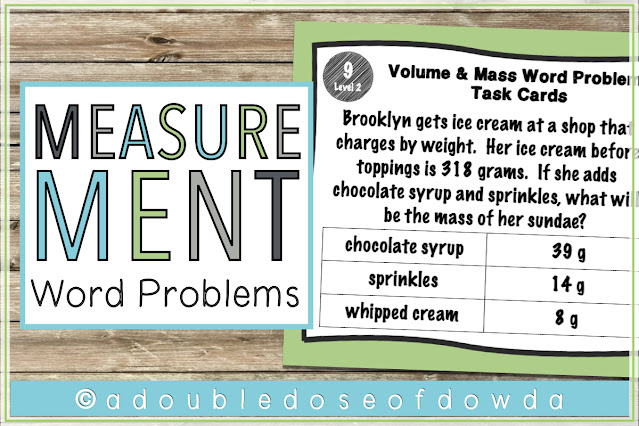
This is how I progress students from the introduction of grams, liters, kilograms, and milliliters all the way up to multi-step word problems.
[10:43] How to support struggling and advanced students with measurement
If students are having trouble with measurement, there are a couple areas that tend to be the main culprits.
[10:53] Student Misconceptions About Units of Measurement
One possibility is that students never really understood the relationship between unit vocabulary and common items. Extra practice with this skill is most appropriate, along with giving them a visual reference like the anchor chart I shared above.
[11:02] Student Struggles with Reading and Approximating Scale Labels
The biggest struggle tends to be trouble with reading and approximating scale labels. Students can typically read something when it comes up to a line that is labeled, but when a measurement falls between lines, that can be difficult.
[11:20] Student Difficulties with Solving One-Step Word Problems
Lastly, students might need some assistance solving word problems. In that case, provide blank copies of scales, beakers, etc. and encourage students to draw pictures to represent what is happening in the problem. Pull in the hands-on manipulatives, if needed, to intervene for solving those word problems.
[11:36] How to Challenge Advanced Students in Measurement
If you have students who are doing really well and need a little bit of a challenge, I like to ask word problems that they have to pull information from tables like the one pictured above. You can also press high-achieving students to read measurements that are fractions so students are not always reading measurements to a whole number.
[11:57] Measurement Activities Examples
I don’t know about you, but I had a tough time finding good resources to use in my classroom for this standard - so I had to make a lot of my own. I have put together some of my favorite activities below in case you might be interested in these student-approved activities for measurement!
This PowerPoint resource takes you through an entire lesson, from start to finish, about grams and kilograms. It has students do everything that I talked about above. This resource includes student notes, along with the PowerPoint that they fill out as they go. It has an exit ticket, and it includes a SCOOT game with different levels of questions. You can use them as task cards or as a SCOOT game. Either is lots of fun. I personally put these cards around my classroom and students use it as a SCOOT game, so they go around the room with clipboards and answer the questions.
I have three different levels of practice worksheets that are fun mazes:
Students always enjoy these mazes, and it's just a fun opportunity for students to practice their skills.
Here is the grams and liters anchor chart that I mentioned earlier. You can print it as a whole sheet or as half-sheets (for interactive notebooks!) as well as a poster so you can hang it on your wall for students to reference.
I also have ready-to-use, fun measurement centers and games:
- A tic-tac-toe where students have to choose what would be the appropriate measurement;
%20Bundle%20Square%20Preview%206.jpeg)
- Volume and Mass Word Problem Task Cards and Matching Game where students solve one- and two-step word problems including problems that require reading tables.
%20Bundle%20Square%20Preview%207.jpeg)
%20Bundle%20Square%20Preview%208.jpeg)
- A whole-class interactive game that has students “racing” to compete with each other about measurements in a zoo
%20Bundle%20Square%20Preview%209.jpeg)
- Volume and Mass BINGO - you will never see students so excited to read exact measurements on scales and beakers!
%20Bundle%20Square%20Preview%2010.jpeg)
If you want ALL of these at a discounted price, you can check out this bundle with all 11 resources!
Lastly, I have a FREE printable handout with big ideas from this post so you can print it and put it in a lesson plan book to remind you of all this good stuff. Please download it and let me know what you think!



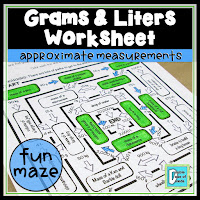

%20Bundle%20Square%20Preview%205.jpeg)
%20Bundle%20Square%20Preview.jpeg)
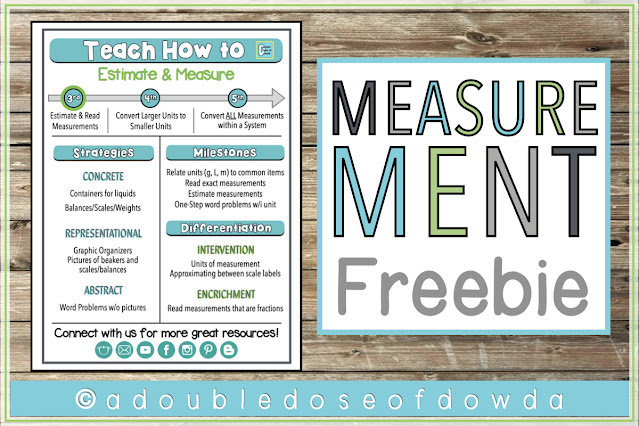
No comments
Post a Comment